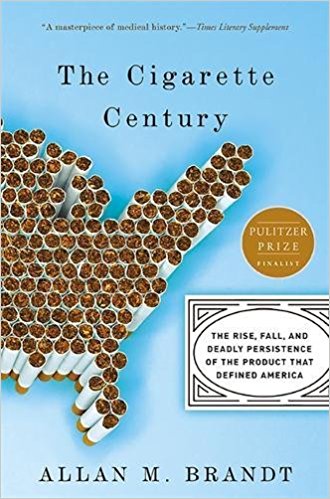The Cigarette Century Summary
5 min read ⌚
 The Rise, Fall, and Deadly Persistence of the Product That Defined America
The Rise, Fall, and Deadly Persistence of the Product That Defined America
Tobacco’s road: how cigarettes have influenced the everyday life, affected the social development, economics, culture and most importantly the health of the American people.
Who Should Read “The Cigarette Century”? And Why?
“The Cigarette Century” is a fascinating, unusual book with intriguing stories about the personal life of one of the greatest entrepreneur of all time – James Buchanan – Duke. Not many books share the same versatility by covering several genres and answering questions from different fields.
Nevertheless, the real meaning lies in the ability to interpret smoking from another angle, not like a habit but more of business. How integration granted Duke an importunity to enforce monopoly and how he fought after the government crashed his intention.
To sum up, we warmly prescribe this magnificent one-of-a-kind book to all people who want to learn more about businesses from a historical point of view.
About Allan M. Brandt
 Allan M. Brandt was born in Washington, D.C in 1953. Currently, he teaches at the Harvard Medical School as a historian of medicine. A few prominent books like “No Magic Bullet: A Social History of Venereal Disease in the United States since 1880” and “Morality and Health” are written by him.
Allan M. Brandt was born in Washington, D.C in 1953. Currently, he teaches at the Harvard Medical School as a historian of medicine. A few prominent books like “No Magic Bullet: A Social History of Venereal Disease in the United States since 1880” and “Morality and Health” are written by him.
He obtained his B.A from Brandeis University and received a Ph.D. in American History while attending Columbia University.
“The Cigarette Century Summary”
The 19th century, known for its industrial development and numerous discoveries, created the first ever cigarette. Shortly after the James Buchanan’s revelation– the person, known to the public as “Duke,” a new way of life was being imposed.
His creation produced a boom on American soil. Before the manufacturing process in 1879 took place, James tested the cigarette effect in order to see how will the audience react. The strange thing was that the community interpreted smoking as some sort of privilege; among the wealthiest.
The invention was followed up by a launching process, 700 cigarette rollers were employed around North Carolina and New York region. In the hope of getting the society addicted to smoking, James geographically dispersed the business.
The transition between non-smokers and smokers lasted for years; Duke had a pure intention to reshape the industry with a technological invention: The cigarette roller. The goal was to speed up the production process, which by some standards should reach more than 200 cigarettes a minute.
On average this is around 60 times more efficient than leaving the task to the most skillful hand roller in the country. Afterwards, several secret meetings took place between entrepreneurs, and they eventually reached an agreement beneficial for both sides.
Successful entrepreneurs always follow one specific formula, not to increase production, but to improve the cost/benefit ratio. Even in the late 19th and early 20th marketing existed. To raise awareness about his brand – cigarettes, Duke started a promotion cycle by relying on investments in ads, postcards, coupons, creating a target group and several other promotion techniques.
This marketing leverage granted him a differentiation clue because the tobacco business has little space for maneuver. Even now, the production is vulnerable to price competition; cigarette manufacturers struggle to offer something new because the market is restricted to one product. The same notion guided James Buchanan giving him insights to focus on consolidation.
The differentiation struggle forced Duke to devise a new strategy for manipulating his opponents. American Tobacco consortium wasn’t just a name; it was an organization that consisted of all American cigarette manufacturers.
The establishment of a tobacco-growing institution led to the creation of new cigarette manufacturing process and more efficient distribution in the hope of increasing profits. From the early 1900s, till 1991 American Tobacco was one of the most profitable U.S.’s companies – or precisely among the first three.
The government realized the problem and confronted the monopoly back in 1911.The tobacco industry’s growth formula lies in the infiltration of smoking as an indispensable part of our lives.
Allan M. Brand wrote this fact-filled, intriguing book, motivated by the smoking-impact and its dangerous side-effects. The Americans deserve to know how it all started. The Harvard professor exposes all facts and documents associated with the early production of cigarettes.
The easy-flow and digestible content is one more reason, to take a quick look and scan this unique book. We don’t interfere with production; we only managed to infiltrate into the behind-the-scenes system as supervisors.
Business historians, health officials, and other neutral knowledge seekers will especially find this book informative and amusing.
Key Lessons from “The Cigarette Century”
1. The fame of smoking
2. History of smoking and public reaction
3. The movement of Non-Smokers
The fame of smoking
Perhaps nowadays, people don’t consider smoking as glamorous as our great-grandparents once interpreted it.
Today, the biggest competition to the “smoking-industry” derives from the fitness industry; developing healthy habits, and adopting a motivational attitude. These concepts are undoubtedly growing in popularity.
History of smoking and public reaction
It’s pretty hard to find an American person who has never smoked a cigarette. It’s equally tricky on a global scale. The devastating effects of smoking are known to the public, and yet the glamour has not vanished entirely.
When looking from another from a broader point of view, smoking is embedded into the American society; it changes history!
The movement of Non-Smokers
During the 70s and 80s, many anti-smoking campaigns occurred in the States. The tobacco industry was a profitable and unregulated organization at the time; Anti-Tobacco movements forced the government officials to enforce some laws on smoking in public places.
Several years later, many companies encouraged by the progress, signed anti-smoking policies.
Like this summary? We’d Like to invite you to download our free 12 min app, for more amazing summaries and audiobooks.
“The Cigarette Century” Quotes
We stand on the threshold of a global pandemic of tobacco-related diseases. Share on X The identification of cigarette smoking as a cause of serious disease shook the tobacco industry to its core. Share on X As a culture, we seek to insist – despite much powerful evidence to the contrary – that smoking remains a simple question of individual agency, personal fortitude, and the exercise of free will. Share on X The cigarette revealed the power of the technique of investing a commodity with cultural meaning...to motivate consumption. Share on X From its inception, the cigarette targeted the uninitiated; young people...were the primary constituency. Share on XOur Critical Review
Smoking tends to get a little annoying or is it? Stats have shown that the percentage of people addicted to cigarettes – usually stagnates for the past 20 years.
Business deals, mind-tricks, entrepreneurial solutions, and financial mysteries are all a part of the package deal – like in this case. If you are more on the historical side, many examples indicate the importance of being a good-decision-maker, nothing has changed even today.
Emir is the Head of Marketing at 12min. In his spare time, he loves to meditate and play soccer.


 The Rise, Fall, and Deadly Persistence of the Product That Defined America
The Rise, Fall, and Deadly Persistence of the Product That Defined America




